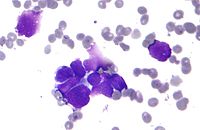
Photo from wikipedia
Background. Increased extravascular lung water during ex vivo lung perfusion (EVLP) is associated with ischemia reperfusion injury and poor pulmonary function. A non-invasive technique for evaluating extravascular lung water during… Click to show full abstract
Background. Increased extravascular lung water during ex vivo lung perfusion (EVLP) is associated with ischemia reperfusion injury and poor pulmonary function. A non-invasive technique for evaluating extravascular lung water during EVLP is desired to assess the transplant suitability of lungs. We investigated real-time lung weight measurements as a reliable method for assessing pulmonary functions in cellular EVLP using a porcine lung model. Methods. Fifteen pigs were randomly divided into 3 groups: control (no warm ischemia) or donation after circulatory death groups with 60 or 90 min of warm ischemia (n = 5, each). Real-time lung weight gain was measured by load cells positioned at the bottom of the organ chamber. Results. Real-time lung weight gain at 2 h was significantly correlated with lung weight gain as measured on a back table (R = 0.979, P < 0.01). Lung weight gain in non-suitable cases (n = 6) was significantly higher than in suitable cases (n = 9) at 40 min (51.6 ± 46.0 versus −8.8 ± 25.7 g; P < 0.01, cutoff = +12 g, area under the curve = 0.907). Lung weight gain at 40 min was significantly correlated with PaO2/FiO2, peak inspiratory pressure, shunt ratio, wet/dry ratio, and transplant suitability at 2 h (P < 0.05, each). In non-suitable cases, lung weight gain at 66% and 100% of cardiac output was significantly higher than at 33% (P < 0.05). Conclusions. Real-time lung weight measurement could potentially be an early predictor of pulmonary function in cellular EVLP.
Journal Title: Transplantation
Year Published: 2022
Link to full text (if available)
Share on Social Media: Sign Up to like & get
recommendations!